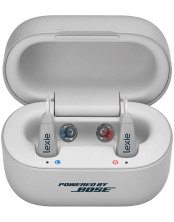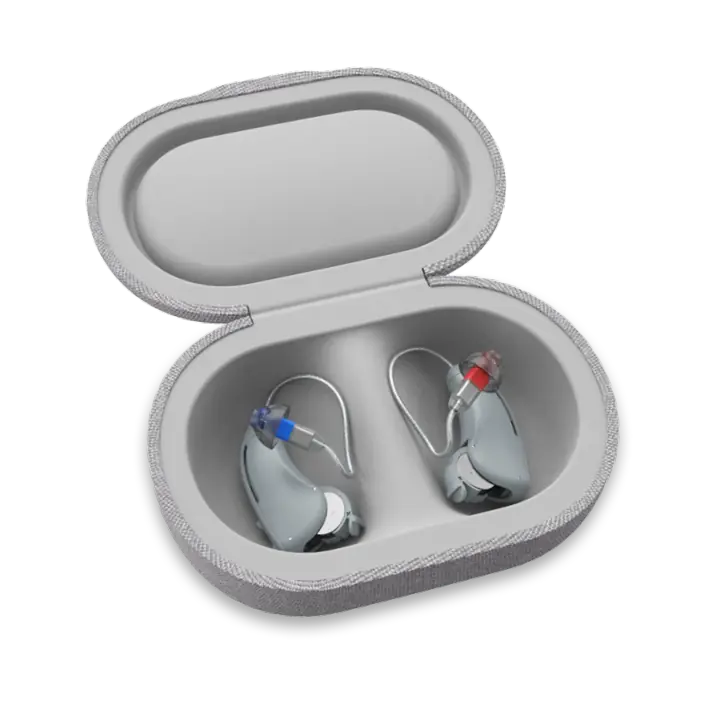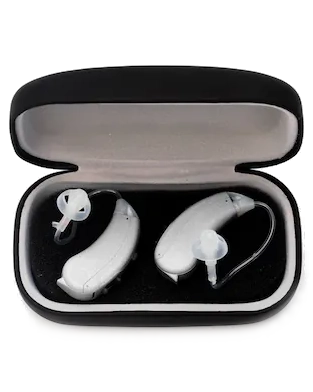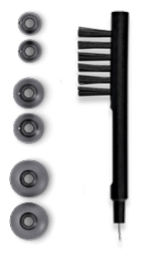Rechargeable Hearing Aids | Pros and Cons
Published: July 21, 2021
Updated: July 19, 2022
As the world and its gadgets become more and more connected, so do hearing aids. The latest technology allows hearing aids to automatically detect the type of environment you’re in. You can now control your hearing aid using your smartphone; and send music and sound directly from your phone, TV, or listening device into your ears. All these features are wonderful but do result in hearing aid batteries draining faster and needing to be replaced more frequently, often at inconvenient times when we’re needing to hear.
To avoid these issues, rechargeable hearing aid batteries have come into focus in the last few years. There are two types of rechargeable batteries. The first type is silver-zinc batteries, which look very much like, and sit in the same battery door as normal hearing aid batteries. Lately, however, most rechargeable hearing aids are using lithium-ion batteries which are completely enclosed in the hearing aid and cannot be removed or even accessed. Instead of opening the hearing aid battery door to switch the aid off when you go to bed, you place the specially designed aids in a charger that recharges their batteries to be ready to use the next day.
As with all exciting new technology, rechargeable hearing aid battery technology does come with some drawbacks. Below are the pros and cons of using rechargeable hearing aid batteries to help you decide whether they would be the right fit for you.
Pros of rechargeable hearing aids
- The convenience of rechargeable hearing aids is their biggest advantage. No more struggling with tiny batteries, it is now as simple as ‘plugging’ them in overnight next to your mobile phone.
- For people with dexterity or visual issues, rechargeable hearing aids are ideal as you no longer need to handle the battery and worry if the battery is inserted correctly.
- Rechargeable batteries give you peace of mind that your hearing aid battery is not going to run out at an inconvenient time when it is difficult to replace; depending on the hearing aid, you can have up to 30 hours of wearing time after one full charge.
- There is no longer the need to remember to buy new batteries and keep spare ones on you which inevitably fall out of their pack and go missing.
- Rechargeable batteries also reduce the number of small parts lying around that children or pets may get hold of.
- For certain hearing aid brands, there may be a long-term financial saving when using rechargeable batteries versus buying new ones every few weeks. Although the cost of the charger and hearing aids upfront makes them more expensive than non-rechargeable, over time it can work out cheaper.
- Silver-zinc batteries generally need to be replaced every six months to a year; lithium-ion batteries can last up to five years. Either way, they represent a significant reduction in the number of hearing aid batteries being thrown away compared with disposables, all the better for the environment.
- Because hearing aids with lithium-ion batteries are a completely closed system, no battery door opens the hearing aid to the outside world, so it is more protected and less susceptible to damage.
- Certain hearing aid brands include a dehumidifier with the charger so that unwanted moisture is absorbed from the hearing aid while it charges.
If you are uncertain about committing to a whole new routine with your hearing aids, there are still some hearing aid companies that are using silver-zinc rechargeable batteries. Although they do not last as long as lithium-ion batteries, they do give the best of both the rechargeable and non-rechargeable worlds; if for some reason you cannot use the charger (due to malfunction or lack of electricity), you can just swap the batteries with normal disposable ones and continue as you used to. Just be sure that you do not confuse which batteries can be used with the charger and which cannot!
Cons of rechargeable hearing aids
- The long-term cost of buying rechargeable hearing aids versus non-rechargeable is variable; over a five-year period (which is how long lithium-ion batteries should last).
- Some rechargeable options work out cheaper, some are about even, while many are much more expensive.
- Because rechargeable hearing aids are still a relatively new technology, we cannot yet say for sure what the maintenance costs will be along the way, thus there may be some hidden expenses.
- If you experience frequent electricity outages or are going somewhere with a limited power supply (such as a camping trip), you will not be able to charge the hearing aids. However, certain manufacturers do have special portable chargers for such occasions that can be used for a few days without needing an electrical outlet.
- That said, when going on holiday, it is vital that you remember to take the charger with you as, without it, your hearing aids will be useless, unlike traditional hearing aid batteries that you can easily buy at the nearest pharmacy.
- Because the battery is contained within the hearing aid and cannot be removed, if the battery malfunctions, the hearing aid cannot be used until it has been repaired, unlike with non-rechargeable batteries that can just be replaced.
- If the battery runs out during the day, you’ll need to wait for it to recharge (a top-up recharge is generally about 30 minutes), compared with just immediately replacing a disposable battery. Using a hearing aid’s streaming capabilities for long periods will make this more likely to happen.
- Not all chargers come with a dehumidifying function, which could leave your hearing aids at risk of moisture damage if you do not balance their dehumidifying time with their charging time.
- Rechargeable lithium-ion battery hearing aids are generally slightly bigger than their non-rechargeable counterparts to ensure that the battery is big enough for the hearing aids’ needs. However, with current technological advances, the difference is often negligible and well worth the increased inconvenience.
Ultimately, rechargeable hearing aids are not necessarily a cost-saving option. Rather, the benefit comes with their ease of use, convenience, and environmental impact. As with all new technology, it may seem scary at first, especially if you are a long-time user of disposable battery hearing aids. But just like with our smartphones and step counting watches, rechargeable battery hearing aids are here to stay, and eventually, we’ll wonder how we ever managed without them.
Lexie hearing aids
Lexie Hearing offers battery-powered hearing aids for you to choose from. Lexie has opted to use size 312 zinc-air batteries to power Lexie Lumen hearing aids, to ensure that the hearing aids are ready when you need them to be. Lexie has made it even easier for you to be sure you have enough batteries through the subscription option. Should you subscribe to Lexie Hearing batteries, tubes and domes will be delivered to you regularly to ensure you don’t run out! There are many benefits to battery hearing aids, including:
- You can set a reminder to change the batteries.
- There will be no charging issues.
- Spare batteries can be left at home and work.
- You have more control over your hearing aids.
- Hearing aid batteries are easily available around the globe.
- These batteries are low in cost.






